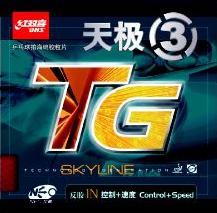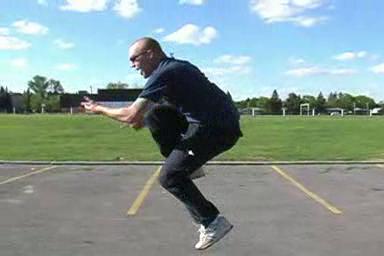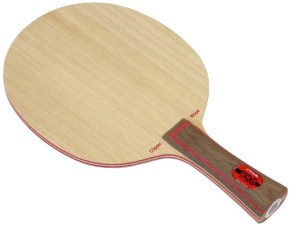|
|
|
max spin of a rubber |
Post Reply 
|
Page 12> |
| Author | |||||
Sofaires 
Super Member 

Joined: 01/12/2012 Location: Puerto Rico Status: Offline Points: 338 |
 Post Options Post Options
 Thanks(0) Thanks(0)
 Quote Quote  Reply Reply
 Topic: max spin of a rubber Topic: max spin of a rubberPosted: 01/15/2012 at 11:07pm |
||||
|
ok quick question, let say that someone have the ability to produce the max spin that a rubber can produce, how do you know that the rubber cannot go beyond that point? i guess its a complicated question but lets focus of the spin during serves and not rallies, if you think that there is no possible way please say so, i like to see different opinions
|
|||||
 |
|||||
| Sponsored Links | |||||
 |
|||||
pnachtwey 
Platinum Member 
Joined: 03/09/2010 Location: Vancouver, WA Status: Offline Points: 2035 |
 Post Options Post Options
 Thanks(0) Thanks(0)
 Quote Quote  Reply Reply
 Posted: 01/16/2012 at 1:35am Posted: 01/16/2012 at 1:35am |
||||
|
Start with how fast you can strike the ball in a direction tangential to the ball. Look at the thread "the fastest serve ever". That serve generated a lot of spin.
|
|||||
 |
|||||
bluebucket 
Platinum Member 
Joined: 02/20/2011 Location: 16 Status: Offline Points: 2882 |
 Post Options Post Options
 Thanks(0) Thanks(0)
 Quote Quote  Reply Reply
 Posted: 01/16/2012 at 3:26am Posted: 01/16/2012 at 3:26am |
||||
|
The time you most easily find the limits of a rubber is in a heavy counter topspin rally, the forces on the rubber then are much higher than anytime in general play. You can feel when things start to go out of whack in the sponge
|
|||||
 |
|||||
pnachtwey 
Platinum Member 
Joined: 03/09/2010 Location: Vancouver, WA Status: Offline Points: 2035 |
 Post Options Post Options
 Thanks(0) Thanks(0)
 Quote Quote  Reply Reply
 Posted: 01/16/2012 at 5:49am Posted: 01/16/2012 at 5:49am |
||||
|
This is about spin generated during a serve.
I don't think the rubber is the limiting factor. One can always brush the ball just a little faster to generate more spin.
|
|||||
 |
|||||
arxidiavol 
Super Member 
Joined: 12/06/2011 Status: Offline Points: 209 |
 Post Options Post Options
 Thanks(0) Thanks(0)
 Quote Quote  Reply Reply
 Posted: 01/16/2012 at 6:20am Posted: 01/16/2012 at 6:20am |
||||
|
In general , the only limitation is tecnique.The speed of arm at the moment of conatct is about 10 meters per second.( men, pros).Can you swing so fast ?
|
|||||
 |
|||||
icontek 
Premier Member 

This is FPS Doug Joined: 10/31/2006 Location: Maine, US Status: Offline Points: 5222 |
 Post Options Post Options
 Thanks(0) Thanks(0)
 Quote Quote  Reply Reply
 Posted: 01/16/2012 at 9:07am Posted: 01/16/2012 at 9:07am |
||||
Service spin and counterlooping spin are produced differently. Service spin is limited to the forces from the toss and your batspeed (and how thin you can make your contact). Counterlooping tests your technique and rubber's ability to REVERSE incoming forces. Looping against underspin, like serving, is limited to your batspeed, but also how how well your contact will CONTINUE (and ADD TO) incoming spin. A rubber that produces the most spin on service (from the same technique) may not be the same rubber that REVERSES spin on counterloops the best. |
|||||
 |
|||||
BH-Man 
Premier Member 

Joined: 02/05/2007 Location: United States Status: Offline Points: 5042 |
 Post Options Post Options
 Thanks(0) Thanks(0)
 Quote Quote  Reply Reply
 Posted: 01/16/2012 at 12:24pm Posted: 01/16/2012 at 12:24pm |
||||
If I understand you right, Player "A" uses Stiga Calibra on his TBS or ALC or whatever and after a time, reaches the point where he gets the maximum spin he can make on serves, openers vs underspin, and on counterloops from mid-distance. You want to zero in on the spin on serving for one metric.
You seem to want to know if there can be even more spin created with the same rubber/blade in these strokes, especially the serves.
My answer is YES, it can go beyond that point. All you need is a player with more effective technique who can make more spin with the same bat. I watch what my club mates give me for serves in various situations, including max bottomspim when they try it. I watch the same serves the same players give the other club mates. I see how much or how little spin is being produced. I have had a few club mates stop practicing with the other club mates and ask me how/why they are not getting even more spin than they are making. (They all know I can make very heavy spin when I want to) I serve using their bat and make 30% more spin on my cut serve, both short and deep. The same opponent who was able to return the same serve from my club mate, now nets my serve, not even close.
A more effective technique is all that is needed. You get heavy spin on cut serves by tossing the ball at least head hight or more, using the whole body, timing everything well, and making good arm and wrist snap, contacting ball at the 6 O'Clock axis for a short serve. Making heavy spin on serve is all about accelleration, timing, and max bat speed at impact. There is always someone who can do it better than the next guy or gal.
BTW, having the ablity to make very heavy spin is a good asset, but not just because it is very heavy. You will not get but a point or two maximum vs a good player by serving him/her only heavy underspin. You need to show the ability to create heavy underspin, so that when you serve with less underspin or even a no-spin using the same service motion and followthorugh, that it looks heavy while it is not. That is what gives you the easy balls to attack for a putaway or strong pressure. We already know this, but what the heck, I think it is good to talk about it again every so often.
|
|||||
|
Korea Foreign Table Tennis Club
Search for us on Facebook: koreaforeignttc |
|||||
 |
|||||
pnachtwey 
Platinum Member 
Joined: 03/09/2010 Location: Vancouver, WA Status: Offline Points: 2035 |
 Post Options Post Options
 Thanks(0) Thanks(0)
 Quote Quote  Reply Reply
 Posted: 01/16/2012 at 12:55pm Posted: 01/16/2012 at 12:55pm |
||||
Yes, now what is an estimate of the upper bound on the max spin?
I hope so. Do you think 10 m/s is fast? Did you convert 10 m/s to mph to sanity check? It is only 22.4 mph. Little high school girls can fast pitch over twice that fast. Why not really try to come up with a real answer or at least a range of plausible answers? Don't cloud the issue counter looping and other BS. Start with an assumption like the blade is horizontal and the ball falls on the blade as the blade is moving towards the net like a ghost serve. This is a good problem to strain your brain on.
|
|||||
 |
|||||
racquetsforsale 
Gold Member 
Joined: 10/02/2010 Location: at the table Status: Offline Points: 1268 |
 Post Options Post Options
 Thanks(0) Thanks(0)
 Quote Quote  Reply Reply
 Posted: 01/16/2012 at 4:26pm Posted: 01/16/2012 at 4:26pm |
||||
|
P,
I think you have to take the type of arm motion into account. It's a lot easier to generate arm speed when throwing. I pitcher may be able to throw 90, but even if he is the most skilled TT player, he cannot loop at that speed or brush the ball at that speed when serving.
|
|||||
 |
|||||
Sofaires 
Super Member 

Joined: 01/12/2012 Location: Puerto Rico Status: Offline Points: 338 |
 Post Options Post Options
 Thanks(0) Thanks(0)
 Quote Quote  Reply Reply
 Posted: 01/16/2012 at 6:41pm Posted: 01/16/2012 at 6:41pm |
||||
i think is good to talk about it too, and i appreciate each and every comment
|
|||||
 |
|||||
igorponger 
Premier Member 

Joined: 07/29/2006 Location: Everywhere Status: Offline Points: 3252 |
 Post Options Post Options
 Thanks(0) Thanks(0)
 Quote Quote  Reply Reply
 Posted: 01/16/2012 at 7:23pm Posted: 01/16/2012 at 7:23pm |
||||
|
http://www.ittf.com/ittf_science/SSCenter/docs/199408014%20-%20%20Tiefenbacher%20-%20Impact.pdf
Look into this study carefully. You could see why the Europians do use non-tacky rubber and thick sponge to get heavy spin on the ball. |
|||||
 |
|||||
Sofaires 
Super Member 

Joined: 01/12/2012 Location: Puerto Rico Status: Offline Points: 338 |
 Post Options Post Options
 Thanks(0) Thanks(0)
 Quote Quote  Reply Reply
 Posted: 01/16/2012 at 8:11pm Posted: 01/16/2012 at 8:11pm |
||||
very interesting, i downloaded it to read it more carefully later on thanks a lot for your post!
|
|||||
 |
|||||
pnachtwey 
Platinum Member 
Joined: 03/09/2010 Location: Vancouver, WA Status: Offline Points: 2035 |
 Post Options Post Options
 Thanks(0) Thanks(0)
 Quote Quote  Reply Reply
 Posted: 01/16/2012 at 8:21pm Posted: 01/16/2012 at 8:21pm |
||||
I have. I did see the point about the non-tacky sponge. Tangential elasticity is more important than tackiness for generating spin. I saw that tackiness slows down the normal speed of the ball. It reduced Epar. I saw where they said the rubber slows down the ball because it absorbs energy. It reduced Epar. This contradicts those that say thicker rubbers are faster. I didn't see where it said it is best to use thick sponges. In this test they didn' t really use thick sponges. I saw some comparison with 1.3mm and 1.8mm rubbers but that is not thick! Notice that there are two main variables in the document. Epar and Tpar. These are the normal and tangential COR. So what does this mean? If the Epar and Tpar are 0.6 and the ball drops from 1 m and lands on horizontal paddles moving 10 m/s, how much spin will be generated? It is obvious that faster the paddle speed and the higher the Tpar the more spin will be generated. Racquestsforsale, who cares about the stroke!!! The ball doesn't care what the paddle did before the instant of impact. Only the current position, velocity and acceleration matter. How they are achieved makes no difference. |
|||||
 |
|||||
Sofaires 
Super Member 

Joined: 01/12/2012 Location: Puerto Rico Status: Offline Points: 338 |
 Post Options Post Options
 Thanks(0) Thanks(0)
 Quote Quote  Reply Reply
 Posted: 01/16/2012 at 8:34pm Posted: 01/16/2012 at 8:34pm |
||||
|
in my opinion and feel free to correct me if im wrong but what you say about the ball doesnt care is partially true, why? well i think that before you make contact with the ball the movements of the body and arm and wrist will help you to get additional speed or spin wich ever you like to apply, if im wrong please correct me
|
|||||
 |
|||||
Hookshot 
Gold Member 
Joined: 07/24/2006 Location: United States Status: Offline Points: 1797 |
 Post Options Post Options
 Thanks(0) Thanks(0)
 Quote Quote  Reply Reply
 Posted: 01/16/2012 at 8:45pm Posted: 01/16/2012 at 8:45pm |
||||
|
Sofaires,
He is correct, the effect on the ball is only affected at "The moment of contact". Yes, how you do the stroke can determine bat speed but he is not talking about that, only "the moment of contact".
|
|||||
 |
|||||
Sofaires 
Super Member 

Joined: 01/12/2012 Location: Puerto Rico Status: Offline Points: 338 |
 Post Options Post Options
 Thanks(0) Thanks(0)
 Quote Quote  Reply Reply
 Posted: 01/16/2012 at 10:05pm Posted: 01/16/2012 at 10:05pm |
||||
|
ahh i see thanks hookshot
|
|||||
 |
|||||
mrdoodzki 
Gold Member 

Joined: 06/10/2011 Location: Australia Status: Offline Points: 1279 |
 Post Options Post Options
 Thanks(0) Thanks(0)
 Quote Quote  Reply Reply
 Posted: 01/16/2012 at 10:20pm Posted: 01/16/2012 at 10:20pm |
||||
|
you guys make my nose bleed...
|
|||||
 |
|||||
pnachtwey 
Platinum Member 
Joined: 03/09/2010 Location: Vancouver, WA Status: Offline Points: 2035 |
 Post Options Post Options
 Thanks(0) Thanks(0)
 Quote Quote  Reply Reply
 Posted: 01/17/2012 at 2:38am Posted: 01/17/2012 at 2:38am |
||||
|
Sofaires, you want to know the maximum spin. Generating maximum spin requires that the paddle hit the ball with a high tangential component to its motion. How fast can you move your paddle while serving? Do you know how to do a ghost serve? http://youtu.be/unCoKMQ7H0o This guy isn't even moving his paddle that quickly. Angling the paddle up a bit allows one to put more spin on the ball and less forward motion. |
|||||
 |
|||||
Sofaires 
Super Member 

Joined: 01/12/2012 Location: Puerto Rico Status: Offline Points: 338 |
 Post Options Post Options
 Thanks(0) Thanks(0)
 Quote Quote  Reply Reply
 Posted: 01/17/2012 at 10:05am Posted: 01/17/2012 at 10:05am |
||||
that help me alot thanks for the post!
|
|||||
 |
|||||
racquetsforsale 
Gold Member 
Joined: 10/02/2010 Location: at the table Status: Offline Points: 1268 |
 Post Options Post Options
 Thanks(0) Thanks(0)
 Quote Quote  Reply Reply
 Posted: 01/17/2012 at 2:02pm Posted: 01/17/2012 at 2:02pm |
||||
How can you say the stroke is unimportant. TT strokes do not resemble throwing a ball. The movements of serving in TT is NOTHING like throwing a ball. You can't engage the same muscles the same way and to the same degree. HELL, even the mechanics of throwing a baseball and football are different! All I'm saying is, it's not valid to justify to someone that since even a small highschool girl can generate more than 20m/s of armspeed WHEN THROWING OVERHAND, he should be able to generate that level of bat speed when serving in TT. |
|||||
 |
|||||
pnachtwey 
Platinum Member 
Joined: 03/09/2010 Location: Vancouver, WA Status: Offline Points: 2035 |
 Post Options Post Options
 Thanks(0) Thanks(0)
 Quote Quote  Reply Reply
 Posted: 01/17/2012 at 5:05pm Posted: 01/17/2012 at 5:05pm |
||||
Easy, the stroke is unimportant. There I just did. I qualify that by saying the ball doesn't care what the paddle was doing before impact and it was the state at the instant of impact that counts. You can have two different strokes and if at the instant of impact the state ( position, velocity , acceleration ) is the same the impulse and results will be the same. If you make the same stroke but hit the ball a millisecond sooner or later the position, velocity and acceleration will not be the same. The results will be different. So much for the stroke being important. Obviously there is a timing component too and at a particular time the paddle will have a certain, position, velocity and acceleration. I should also add that the rotation of the paddle is important too ( yaw, pitch and roll and their derivatives ) but that just confuses the issue even more. It is also obvious that we are more likely to achieve hitting the ball with the paddle in the same state if we use the same stroke but get this, the stroke is not important in the physics of things.
So? I never said it did but because TT is so lame there isn't good sports data for TT so I had to use another sport, girls fast pitch softball, as an example to make a point. Has anybody in the TT world ever put a 3D accelerometer on the back of a blade just to measure position, velocity and acceleration during various strokes? I haven't seen the data and I have looked. So how do you know what the limits are?
I didn't say over hand. I was referring to under hand pitching in girls fast pitch softball. http://www.pitchsoftball.com/Page8.html Pitching under handed has got be be slower than pitching side arm where you can really twist your body for extra speed.
Wimp. Beat by a 14 yr old high school girl. The point I was making is that we can swing the paddle more than fast enough. 10 m/s is easy. Even a high school girl can do it. Some didn't think so. It is control and physics that is the limiting factor. Did you see the fastest serve ever thread? Look at the swing. I don't think he is swinging at 20 m/s but I doubt he is anywhere near his maximum either. If you swing a paddle at 10 m/s and you are doing a ghost serve you have only about a 15 millisecond where the paddle will be under the ball. The toss and swing must be precise. At 20 m/s the window is half that. The window is even even smaller if you want to hit the middle of the paddle. I don't think speed is an issue. Timing is. I would miss a lot of serves. |
|||||
 |
|||||
racquetsforsale 
Gold Member 
Joined: 10/02/2010 Location: at the table Status: Offline Points: 1268 |
 Post Options Post Options
 Thanks(0) Thanks(0)
 Quote Quote  Reply Reply
 Posted: 01/17/2012 at 5:37pm Posted: 01/17/2012 at 5:37pm |
||||
|
I appreciate the perspective you bring to the discussions on this forum because I think along the same lines, quantifying certain elements of the game, but I also take a further step to think about how my body needs to move to produce those vectors and impulses. I think that's what the typical forum member who is new to the sport is after. I think people will be more receptive if you don't just throw a bunch of numbers and physics principles at them to dismiss their views, especially if you've missed the point they're making. I'm not challenging your physics; I'm not challenging what the max arm speed a typical adult male can achieve. My point was and still is you are ignoring the constraints under which a TT player must produce those swing speeds. Being able to produce 22m/s of arm speed throwing overhand or UNDERHAND with a HUGE windup and being able to produce the same blade speed with a much much more compact motion when serving in TT are two different things.
|
|||||
 |
|||||
swampthing 
Super Member 

Joined: 02/15/2011 Location: USA Status: Offline Points: 176 |
 Post Options Post Options
 Thanks(0) Thanks(0)
 Quote Quote  Reply Reply
 Posted: 01/17/2012 at 11:04pm Posted: 01/17/2012 at 11:04pm |
||||
Thanks for your post! I was looking for a concept/term to describe the way some rubbers really conserve the incoming ball's angular momentum or spin (like Tenergy, Hexer HD, tensors, etc) and the way others absorb it (Anti, certain pips and untuned sheets, etc) and how some can be tacky and still absorb spin (Some untuned Chinese rubbers). Drum roll... Tangential Effect! (pg. 3) Hmm, perhaps that's why people tune, to increase the tangential effect. Anyways, I've always wished manufacturers listed a 'tackiness' rating and tangential effect rating separately to describe the 'spin' of a rubber.
|
|||||
|
Xiom Zetro Quad: FH: Hexer HD, BH: Hexer HD
Galaxy K-4: Tibhar Nimbus Medium, Palio Blitz |
|||||
 |
|||||
Sofaires 
Super Member 

Joined: 01/12/2012 Location: Puerto Rico Status: Offline Points: 338 |
 Post Options Post Options
 Thanks(0) Thanks(0)
 Quote Quote  Reply Reply
 Posted: 01/17/2012 at 11:09pm Posted: 01/17/2012 at 11:09pm |
||||
|
swampthing thats actually not a bad idea i would like to see the tackiness and tangential rating
|
|||||
 |
|||||
pnachtwey 
Platinum Member 
Joined: 03/09/2010 Location: Vancouver, WA Status: Offline Points: 2035 |
 Post Options Post Options
 Thanks(0) Thanks(0)
 Quote Quote  Reply Reply
 Posted: 01/18/2012 at 3:08pm Posted: 01/18/2012 at 3:08pm |
||||
|
So what does an Tpar of 0.5 mean? If Sofaires does a ghost serve with the paddle horizontal but moving at 10 m/s then how fast will the ball be moving and how fast will it be spinning?
|
|||||
 |
|||||
swampthing 
Super Member 

Joined: 02/15/2011 Location: USA Status: Offline Points: 176 |
 Post Options Post Options
 Thanks(0) Thanks(0)
 Quote Quote  Reply Reply
 Posted: 01/21/2012 at 3:52pm Posted: 01/21/2012 at 3:52pm |
||||
|
According to the report, a rubber with Tpar of .5 would be the ball loses approx. half of it's surface velocity.
IMHO, their coverage of tangential effect is over-simplified as their Tpar formula and Figure 1 does not include a variable for the velocity of the ball as a whole.
However, as over-simplified as it is, my estimate for a Tpar of .5 would be the total of half the ball's incoming spin velocity plus half of the racket's surface velocity. So, for a serve using the lowest legal toss, the ball's pre-impact surface velocity would be near zero, thus making the resulting spin approx. half of the racket velocity. |
|||||
|
Xiom Zetro Quad: FH: Hexer HD, BH: Hexer HD
Galaxy K-4: Tibhar Nimbus Medium, Palio Blitz |
|||||
 |
|||||
smackman 
Assistant Moderator 
Joined: 07/20/2009 Location: New Zealand Status: Offline Points: 3264 |
 Post Options Post Options
 Thanks(0) Thanks(0)
 Quote Quote  Reply Reply
 Posted: 01/21/2012 at 5:39pm Posted: 01/21/2012 at 5:39pm |
||||
the survey is a little old now Chinese rubbers have improved and the most popular brands used now, wern't invented then and more different softnesses and better sponges are available now A High level Chinese player dosn't loop the ball at the same place as most Euro players (what Im trying to say that a tacky rubber is very effective if used in a more at the ball technique compared to letting the ball drop and then looping) I thought tacky Chinese rubbers are fantastic for spin serves Maximum spin is just one small part of serving and deception, variance, length, angle, placement and sometimes less spin are all components of serving
|
|||||
|
Ulmo Duality,Donic BlueGrip C2 red max ,Yinhe Super Kim Ox Black
NZ table tennis selector, third in the World (plate Doubles)I'm Listed on the ITTF website |
|||||
 |
|||||
swampthing 
Super Member 

Joined: 02/15/2011 Location: USA Status: Offline Points: 176 |
 Post Options Post Options
 Thanks(0) Thanks(0)
 Quote Quote  Reply Reply
 Posted: 01/21/2012 at 6:05pm Posted: 01/21/2012 at 6:05pm |
||||
Yes, I think dead ball serves are underrated.
 |
|||||
|
Xiom Zetro Quad: FH: Hexer HD, BH: Hexer HD
Galaxy K-4: Tibhar Nimbus Medium, Palio Blitz |
|||||
 |
|||||
dingyibvs 
Gold Member 

Joined: 05/09/2011 Location: California Status: Offline Points: 1401 |
 Post Options Post Options
 Thanks(0) Thanks(0)
 Quote Quote  Reply Reply
 Posted: 01/21/2012 at 8:24pm Posted: 01/21/2012 at 8:24pm |
||||
The conclusion is basically correct, but your understanding is not quite there. The Tpar formula does include the velocity of the ball as a whole, as this quote indicates: "...relative tangential contact velocity (which is produced by rotation and tangential velocity)...." That is, the two variables used in the Tpar formula are both a sum of the surface rotational velocity and the tangential velocity. The actual surface rotational velocity of a ball struck perfect at the bottom with a racket moving at 10 m/s would then be ROUGHLY 5 m/s. The actual number would be 5 m/s MINUS the tangential velocity of the ball(i.e. the speed with which it moves forward). Since its forward moving speed is probably fairly small compared to the rotational speed, the speed of rotation can thus be considered to be roughly 5 m/s. This is also assuming that the ball is tossed perfectly vertically up with no initial tangential velocity or rotation. How high the ball is tossed is irrelevant to this calculation.
|
|||||
|
Blade: Hurricane Long 5 (968) FL
FH: D09C max BH: D09C max |
|||||
 |
|||||
swampthing 
Super Member 

Joined: 02/15/2011 Location: USA Status: Offline Points: 176 |
 Post Options Post Options
 Thanks(0) Thanks(0)
 Quote Quote  Reply Reply
 Posted: 01/21/2012 at 11:44pm Posted: 01/21/2012 at 11:44pm |
||||
Ah yes, you could add a percentage of the axis vector (speed of the ball as a whole) to the tangential vector (speed of point on surface) for a total tangential velocity, i.e. if both vectors are in the same direction or parallel, then you could add 100% of the axis vector to the tangential vector. I departed from the assumption that the axis vector would be perpendicular to the tangential vector in pnachtwey's example, thus making the toss irrelevant. I guess I heard "ghost serve" and envisioned a player trying to strike the ball upward to get the toss to matter.  Thanks for helping kick the cobwebs loose. It's been a while since my last physics course.  |
|||||
|
Xiom Zetro Quad: FH: Hexer HD, BH: Hexer HD
Galaxy K-4: Tibhar Nimbus Medium, Palio Blitz |
|||||
 |
|||||
Post Reply 
|
Page 12> |
|
Tweet
|
| Forum Jump | Forum Permissions  You cannot post new topics in this forum You cannot reply to topics in this forum You cannot delete your posts in this forum You cannot edit your posts in this forum You cannot create polls in this forum You cannot vote in polls in this forum |
|
Forum Home | Go to the Forums | Forum Help | Disclaimer
MyTableTennis.NET is the trading name of Alex Table Tennis Ltd. |